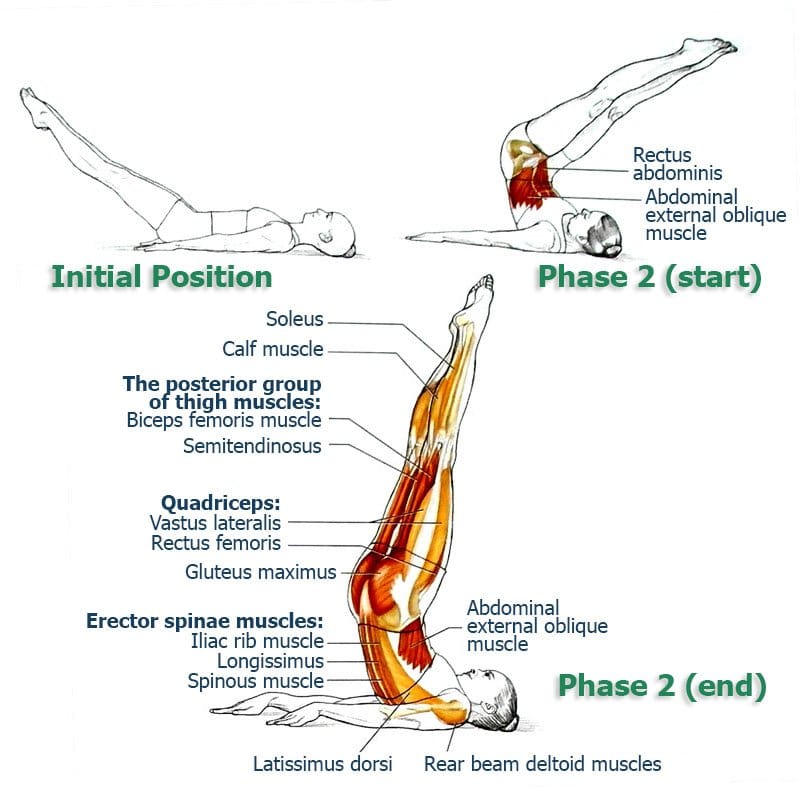Congratulations, you’ve reached the conclusion of our program! Give yourself a tap on the shoulder, just one more exercise. We left Jackknife for the end, because you will face some additional challenges like alternate flexion and extension of the spine. With both legs are raised vertically, it also become difficult to maintain a balance. However, this is one of our favourite exercises – it brings variety to the program and is very useful for a balanced development of the back muscles. Enjoy!
The series so far:
- Exercise #1: Rolling Over
- Exercise #2: Seal
- Exercise #3: Crab
- Exercise #4: Rocking Chair
- Exercise #5: Extended Legs Back Roll
- Exercise #6: Boomerang
- Exercise #7: Controlled Balance
- Exercise #8: Jackknife (you are here)
Exercise #8: Jackknife

Initial position. Lie on your back, stretch your arms at your sides with palms facing down. Raise straightened legs at an angle of about 60 degrees, or even higher as long as you have your pelvis in a stable position. Gently pull your toes, extending them outward. From this position, the legs are lifted further, bending at the hip at an angle of 90 degrees:
- Breathing in, bend the spine, lift your pelvis and lower back of the mat, without changing the 90 degrees angle at the hip. Now, extend your legs straight up;
- Breathing out, slowly lower the body to the mat. Once the pelvis finds a stable support, again raise your legs straight up (initial position). Repeat the exercise 5 times.
Make Sure You:
- Pull-in the stomach to keep a stable position of the pelvis and prevent subsidence in the waist, when the hip flexor muscles begin raising the legs off the floor in the 1st phase of the exercise;
- At the beginning of 2nd phase, using the abdominal muscles, tilt the pelvis back and progressively, vertebra by vertebra, raise your torso. Use the hip extensor muscles to maintain a constant angle between the torso and legs and then to raise them straight up at the end of the 2nd phase;
- During the leg raise, press the hands down firmly on the mat, as they also help to raise the trunk. At the same time the spine extensors muscles straighten the trunk, bringing all the weight on your shoulders;
- Control the movement of the body in the 3rd phase of the exercise, when it’s lowered to the initial position. Use the abdominal muscles again to move the pelvis from the back tilt to a neutral (stable) position to end the movement;
- During the entire course of the exercise legs must be fully extended and toes pointed outwards;
- The mental image: as the name of the exercise suggests, imagine your body as a jackknife, which opens (extension) and closes (bending) in the hip joint.
Additional Notes
The Jackknife exercise combines many useful elements from Extended Legs Back Roll, such as the dynamic stretching of the posterior group of thigh muscles and the spine extensor muscles. However, here we are faced with additional difficulties in the form of alternate flexion and extension of the spine. In addition, maintaining a balance becomes much more demanding when both legs are raised vertically. This on the other hand is useful for a balanced development of the back muscles. It also brings some variety to a routine based on exercises which tend to focus only on bending the spine.
Modifications
You can support the lower back with your hands and bring the legs over the head only as far as the flexibility of the back and posterior thigh muscles allows. This modification helps to reduce the load on the neck. Still, you should consult with your doctor to make sure there are no contraindications from the exercise or the modification.
Optional
Once you gain enough experience and routine, you can bring the legs behind your head all the way until they touch the mat in the 2nd phase, and then lifting the legs to straighten the body to a vertical position.
That’s it, end of the line! We hope you enjoyed this program and that the benefits were worth the trouble. If you like this program, you can check the other two from the same series: Exercises to Improve Your Posture and Bring Relief to Your Back & Spine and Abdominal Exercises for Spinal and Core Movement and Stabilization. Cheers!

